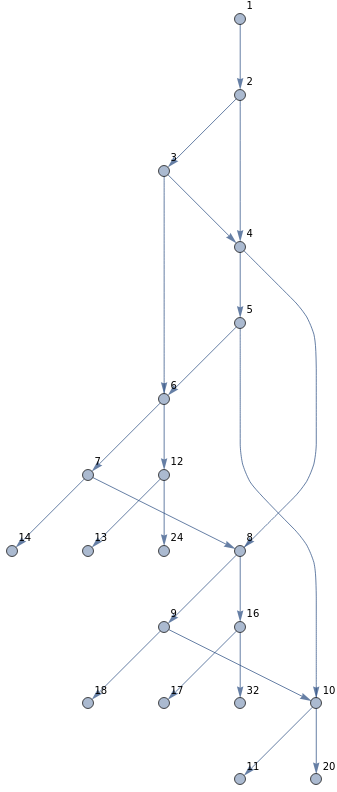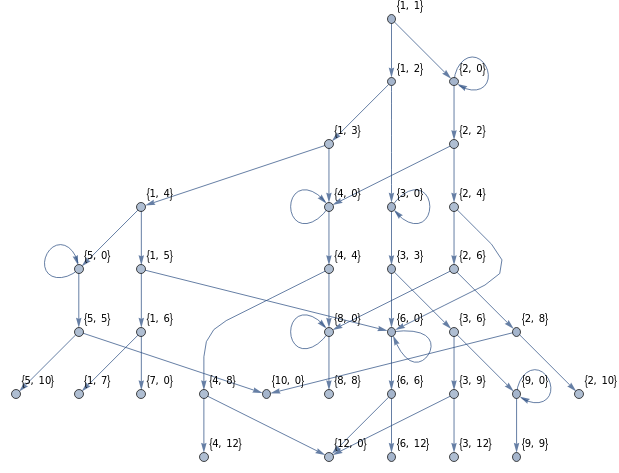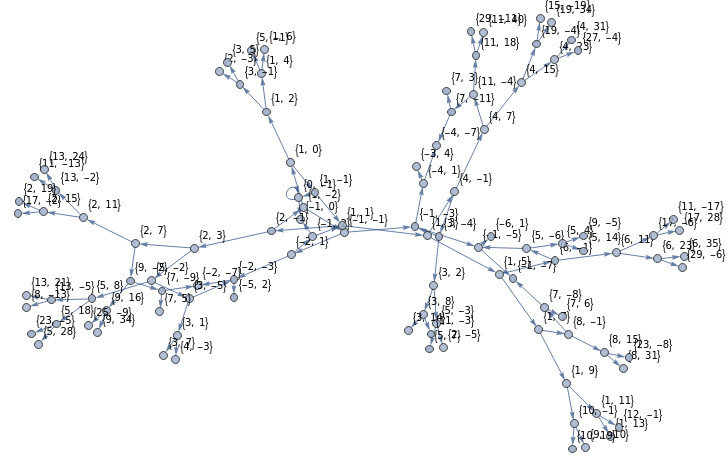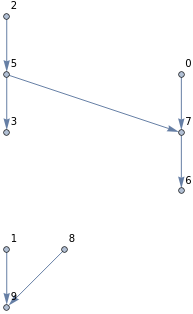In[]:=
NestGraph[n|->{n+1,2n},{1},5,VertexLabelsAutomatic]
Out[]=
In[]:=
MultiwayMatrix[{m1_,m2_},t_Integer]:=With[{g=NestGraph[(f/@{m1.First[#],m2.First[#]})&,{f[{1,1}]},t]},g]
In[]:=
MultiwayMatrix[{m1_,m2_},t_Integer,VertexLabelsAutomatic]:=With[{g=NestGraph[(f/@{m1.First[#],m2.First[#]})&,{f[{1,1}]},t]},Graph[g,VertexLabels((#InputForm[First[#]])&/@VertexList[g])]]
In[]:=
MultiwayMatrix[{{{1,0},{1,1}},{{1,1},{0,0}}},6,VertexLabelsAutomatic]
Out[]=
In[]:=
MultiwayMatrix[{{{1,0},{2,1}},{{1,1},{-1,0}}},6,VertexLabelsAutomatic]
Out[]=
In[]:=
{{1,0},{1,1}}.{x,y}
In[]:=
{{1,1},{0,0}}.{x,y}
Out[]=
{x+y,0}
{x,y}->{x,x+y},{x,y}->{x+y,0}
In[]:=
Table[RandomInteger[10]->RandomInteger[10],7]
Out[]=
{07,53,19,25,57,89,76}
In[]:=
Graph[%,VertexLabels->Automatic]
Out[]=
Any point not in a past or future light cone of a given point can be in an antichain with that point
In[]:=
GraphDistanceMatrix
Out[]=
{{0,1,∞,∞,∞,∞,∞,∞,2},{∞,0,∞,∞,∞,∞,∞,∞,1},{∞,1,0,1,∞,∞,∞,∞,2},{∞,∞,∞,0,∞,∞,∞,∞,∞},{∞,∞,∞,∞,0,1,∞,∞,∞},{∞,∞,∞,∞,∞,0,∞,∞,∞},{∞,2,1,2,∞,∞,0,∞,3},{∞,∞,∞,∞,∞,1,∞,0,∞},{∞,∞,∞,∞,∞,∞,∞,∞,0}}
In[]:=
-GraphDistanceMatrixReverseGraph
Divide the sequence of points into sets so that only spacelike separated points appear in any given set.
Says to which slice each point is assigned
Actually, in the foliation, the slices should be ordered......
[ Relation to Markov blanket ? ]
What must be sequential, what can be in parallel? How many separate steps can be needed in a computation assuming arbitrary parallelism
Can we think about this in terms of lattice theory?
What is the graph of possible foliations? [A multiway graph] [This would be a graph of all possible time orderings for another multiway graph] [Each “time ordering” is a foliation, i.e. a reference frame]
Every node of the “orderings multiway graph” is an antichain
A foliation is a “spacelike coarse graining”
A foliation is a “spacelike coarse graining”
Original multiway graph has “state nodes” [each node is a global state]
Orderings graph has nodes which are antichains (i.e. sets of state nodes)
Orderings graph has nodes which are antichains (i.e. sets of state nodes)
Given a multiway graph (or a causal graph), what are the possible foliations that one can generate, and which ones are “civilized”?
Each path in the antichains graph is a foliation; some are more civilized than others
The civilized foliations are ones whose description is compressible, perhaps lossily
[ Correspondence between foliations and spanning timelike graph ]
Space requires a notion of simultaneity
Space requires a notion of simultaneity
If the system is ultimately ergodic, with this definition there can be no space
[e.g. ergodic wrt the atoms of space] [ or wrt tokens]
[e.g. ergodic wrt the atoms of space] [ or wrt tokens]
To make a persistent notion of space, we need equivalence classes in time [i.e. we need to associate each atom of space with its “successor atom”, which is not trivial because there are interactions between the atoms]
In the hypergraph system, “tokens” are relations between atoms of space
In the list-numerical multiway systems, “tokens” are the lists of numbers
In the list-numerical multiway systems, “tokens” are the lists of numbers
Complexity of finding foliations [anti-timelike surfaces]
Complexity of finding foliations [anti-timelike surfaces]
Finding foliations is stricter than finding antichains ;; i.e. in a foliation we are chaining the antichains
How do we actually find foliations? Assuming there’s permanence to space, we can do it with arrays of light signals [relativistic analog of structured light..]
Foliation is about sequentialization (which we can interpret as time)
Foliation is about sequentialization (which we can interpret as time)
We normally have multiway graphs....
Our underlying model has microsequentialization already it, because every event has a past and future...
If events (AKA functions) are defined not by edges but by directed hyperedges, basically everything works the same....
Rulial multiway system
Rulial multiway system
- A multiway system with all possible rules
-
Fibrations are like families of timelike edges; foliations are like spacelike/branchlike/rulelike space



